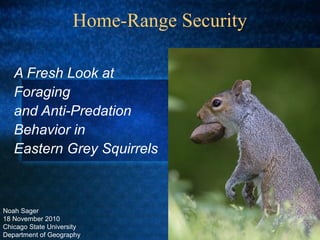
Foraging and Anti-Predation Behavior in Eastern Grey Squirrels
- 1. Home-Range Security A Fresh Look at Foraging and Anti-Predation Behavior in Eastern Grey Squirrels Noah Sager 18 November 2010 Chicago State University Department of Geography
- 2. The Field Behavioral Ecology The study of an animal’s behavior (decisions) dependent upon its environment, and the conferred adaptive benefits or costs Behavioral Geography The study of a human’s behavior (decisions) dependent upon its environment, and the conferred adaptive benefits or costs
- 3. Why Psychoanalyze Animals? “True” Science Applications Correlations http://www.cartoonstock.com/lowres/sma0070l.jpg
- 4. The Eastern Grey Squirrel (Sciurus carolinensis) Small (~400g) Scatter-hoarding Diurnal Spatial Memory Nests Intermittent Locomotion http://www.sciencedaily.com/images/2009/07/090728102303-large.jpg
- 5. Definitions Anti-Predator Vigilance ‘Early-warning’ behavior that enables animals to avoid predation (e.g. predator detection) Intermittent Locomotion Cyclical movement of motion, pause (vigilance), motion Foraging The gathering and subsequent consumption or scatter-hoarding of food items Scatter-hoarding The burying or hoarding of food items in individual locations
- 6. Pause Postures Left to Right Extended Upright Upright Semi-Upright Quadrupedal Up* Quadrupedal Down* Tripedal*
- 7. Previous Studies Wistrand (1974) Newman et al. (1988) http://farm4.static.flickr.com/3402/3261412644_9a6c4be2c1.jpg Jones (1998) McAdam & Kramer (1998) Tchabovsky et al. (2001) Trouilloud et al. (2004) http://www.hiltonpond.org/images/ChipmunkEastern06.jpg
- 8. Anti-Predator Vigilance: Feed or Flee? Study Area Urban parks around Montreal, Quebec (Canada) Summer of 2004 Description The non-invasive video recording of squirrel behavior at artificial foraging patches with varying distances from cover Materials digital video camera, food dish, measuring tape, sand, stakes peanuts, peanut butter, sunflower seeds
- 9. Anti-Predator Vigilance: Food or Foe? Methods 36 squirrels (1 per site) 100m distance between sites http://insidevalleyforgepark.pbworks.com/f/IMG_0186.JPG 3 distances from cover (0.3m, 5m and 15m) Newman et al. (1988) Food patch: 1 liter ‘treated’ sand patch with inverted food dish 25 whole sunflower seeds (15 buried), 1/4 tsp. creamy peanut butter, 5 whole peanuts Confounding conspecifics End of trial requirements
- 10. Anti-Predator Vigilance: Forage or Die Trying Data Extraction Noldus Observer Digital recordings analyzed frame-by-frame Behavior Durations and Frequency Locomotion Pauses Transition Times Motion to Pause (locomotion to vigilance) Pause to Pause (pause posture to posture) Pause to Motion (vigilance to locomotion)
- 11. Anti-Predator Vigilance: It’s a Dog Eat Squirrel World Data Analysis One and two-way ANOVAs (analysis of variance) Bonferroni corrections (post-hoc) Question 1: Are more upright (more vigilant) pause postures really more costly? Question 2: Are transition durations dependent upon pause posture? Question 3: Is there an effect of distance from cover on pause duration or transition times? Question 4: Is there a vigilance component to foraging?
- 12. Results Pause durations varied significantly depending upon posture, with upright pauses lasting longer than semi- upright pauses (F2,52=8.657, P<0.01), and semi-upright pauses lasting longer than quadrupedal pauses (F2,46=3.115, P<0.01), and this was still significant following a Bonferroni post-hoc test.
- 13. Results Posture type had a significant effect on transition times, requiring more time for a squirrel to move from locomotion to a semi-upright posture than to a quadrupedal posture (F2,52=49.396, P<0.01) and more time to move to locomotion from a semi-upright posture than from a quadrupedal posture (F2,66=68.910, P<0.01), and this was still significant following a Bonferroni post-hoc test.
- 14. Results There was a slight effect of distance on transition times to move from locomotion to quadrupedal alert (F2,44=0.067, P=0.057), but no effect from locomotion to semi-upright alert posture (F2,42=0.270, P=0.758). Accordingly, there was no effect of distance on transition times moving from quadrupedal alert to locomotion (F2,58=0.065, P=0.352), to semi-upright alert (F2,32=0.351, P=0.707), or from semi-upright alert to locomotion (F2,49=0.600, P=0.553). There was no effect of distance from cover on pause duration for all postures (F3,31=0.902, P=0.409).
- 15. Results Left: Frequency Distribution of Quadrupedal Pauses During Locomotion. Duration category is measured by number of frames (1 Frame = 1/30 seconds). n = 624, mean = 3.92, median = 8. Right : Frequency Distribution of Quadrupedal Pauses In Patch. Duration category is measured by number of frames (1 Frame = 1/30 seconds). n = 164, mean = 14.37, median = 7. (see: Makowska & Kramer 2007)
- 16. Discussion Question 1: Are more upright (more vigilant) pause postures really more costly? Supported (first empirical evidence) Question 2: Are transition durations dependent upon pause posture? Supported (first empirical evidence) Question 3: Is there an effect of distance from cover on pause duration or transition times? Failed to support (contrary to previous studies) Question 4: Is there a vigilance component to foraging? Failed to support (requires future studies)
- 17. Conclusion(s) Vigilance is costly Positive correlation between pause duration and posture, and between transition time and posture Constrained decisions, time-budget Squirrels maintain a constant time-budget concerning foraging and anti-predation activities Vigilance trade-offs Distance from Cover versus Detection Range*
- 18. Acknowledgements McGill University - Behavioural Ecology Lab 2004 - 2005 Dr. Donald L. Kramer Research Supervisor Talya Hackett Field Assistant The Squirrels Numbers 1 - ?
- 19. Questions or Comments? http://pixdaus.com/pics/1226742504ehmpYPF.jpg
